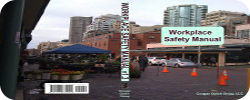OSHA defines first aid as the emergency care provided for injury or sudden illness before emergency medical treatment is available. The first aid provider in the workplace is someone who is trained in the delivery of initial medical emergency procedures, using a limited amount of equipment to perform a primary assessment and intervention while awaiting arrival of emergency medical service (EMS) personnel. First aid providers are protected from lawsuits by Good Samaritan laws in most states.
Every workplace and work site are required to have at least one first aid kit. When larger operations or multiple operations are being conducted at the same location, employers should determine the need for additional first aid kits at the worksite, additional types of first aid equipment and supplies and additional quantities and types of supplies and equipment in the first aid kits.
OSHA advises employers who have unique or changing first-aid needs in their workplace may need to enhance their first-aid kits. The employer can use the OSHA 300 log or other reports to identify these unique problems. Consultation from the local fire/rescue department, appropriate medical professional, or local emergency room may be helpful to employers in these circumstances. By assessing the specific needs of your workplace, you can ensure that reasonably anticipated supplies are available.
OSHA does not have a minimum requirement for first aid kits, but references ANSI Z308.1-2003 Minimum Requirements for Workplace First Aid Kits (see Appendix A to 1910.151 and 1926.50).
Eight items comprise the ANSI Z308.1-2003 Minimum Requirements for Workplace First Aid Kits:
- 1 each – absorbent compress, 32 sq. in. (81.3 sq. cm.) – minimum side 4 in. (10 cm)
- 16 each – adhesive bandages, 1 in. x 3 in. (2.5 cm x 7.5 cm)
- 1 roll – adhesive tape, 5 yd. (457.2 cm) total
- 10 – packets of antiseptic, 0.5g (0.14 fl oz.) applications
- 6 applications – burn treatments, 0.5 g (0.14 fl. oz.)
- 2 pairs – medical exam gloves (latex or non-latex)
- 4 each – sterile pads, 3 in. x 3 in. (7.5 x 7.5 cm)
- 1 each – triangular bandage, 40 in. x 40 in. x 56 in. (101 cm x 101 cm x 142 cm)
ANSI Z308.1-2003 recommends the following nine additional items:
- 4 each – 2×2 inch bandage compresses
- 2 each – 3×3 inch bandage compresses
- 1 each – 4×4 inch bandage compresses
- 1 each – eye patch
- 1 ounce – eye wash
- 1 each – chemical cold pack, 4×5 inch
- 2 each – roller bandages, two inches wide
- 1 each – roller bandage, three inches wide
- 1 each – CPR barrier device
In addition to the ANSI standard, Cougar Gulch Group, LLC recommends the following dozen items:
- 1 each – Face Shield
- 2 each – Surgical Mask or N95 Pocket Mask to prevent possible airborne infections
- 1 each – Apron
- 2 each – Moleskin for blister treatment and prevention
- 6 each – Butterfly Closure Strips
- 1 each – Hemostatic Agents to promote blood clotting for severe bleeding
- 1 each – Trauma Shears for cutting clothing and general use – at least have Scissors
- 1 each – 4inch Tweezers
- 1 each – Lighter or dozen Matches for sterilizing tweezers and shears
- 1 each – Space Blanket AKA emergency blanket
- 6 packages – Aspirin for central medical chest pain as an anti-coagulant
- 1 each – First Aid Instruction chart or booklet
The International Organization for Standardization (ISO) set the standard for first aid kits to be green with a white cross. However, it is acceptable for first aid kits to be white with a green or a red cross. All first aid kits should be kept in clean, waterproof containers to keep the contents safe and aseptic. Kits should also be checked regularly and restocked if any items are damaged or out of date.

